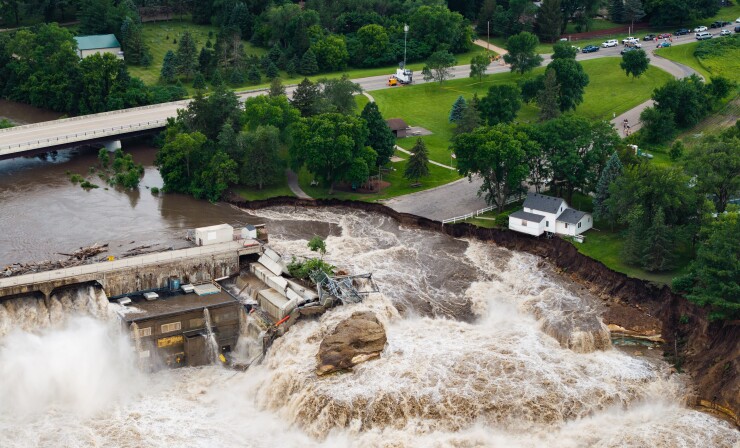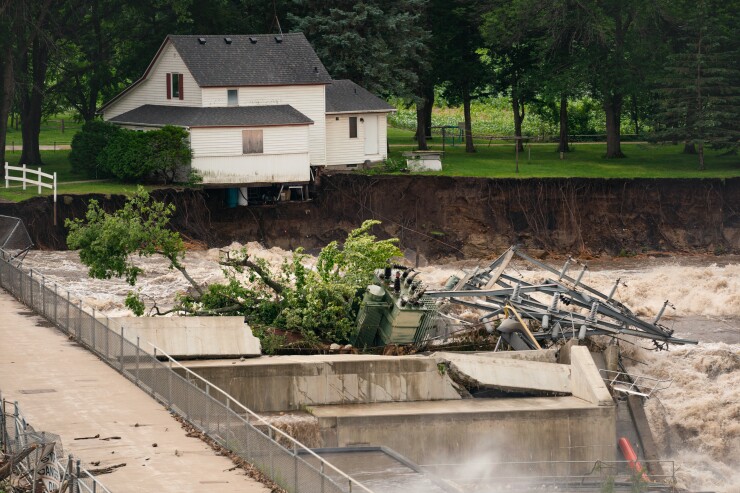When the west abutment on Minnesota's Rapidan Dam partially failed last week, officials initially feared a total collapse.
The dam did not collapse, but storms caused water to overflow it, debris to clog parts of it and the flood flows to ultimately generate so much erosion that waters ultimately went around the dam. For days, workers could not get in to clear the debris because the current was too swift.
Located near Mankato, about 80 miles south of Minneapolis, in Blue Earth County, the 114-year-old dam was rated in poor condition with a potential hazard classification of "significant" in the

Now the decision on whether to repair the Rapidan Dam or remove it falls to the Blue Earth County board of commissioners.
Two 2021 feasibility studies conducted for the county by Barr, a Minneapolis environmental consulting and engineering firm, found that the county could
The latter option could cost as much as $82 million, and would likely require the state to issue bonds, Barr said in its study.
Barr referred all questions to a spokesperson for Blue Earth County, as did the chair of the board of commissioners, Kevin Paap.
"At this time we continue to evaluate mitigation options and have not had conversations about long-term strategies," said Jessica Anderson, communications manager for Blue Earth County. She said the timeframe for a decision on repair versus removal is "unknown."
Any plan to repair the dam would have to reckon with the additional damage caused by June's flooding. Erosion from flows caused by the damaged dam sent one building into the river, and the county demolished another before it could follow.
The decision facing Blue Earth County is one that a growing number of local governments will have to tackle as climate change collides with aging infrastructure.
These are not new concerns to dam engineers, but the problem is usually less with dam design than with the need for regular assessments of changing structural conditions and changing loading conditions, which are driven largely by climate, said Mike Rogers, global dams practice leader at Stantec, an engineering and project management services firm.
"Climate is a deterministic loading condition for dams in that we learn more about the conditions as we collect more and more data through time," he said. "Climate influences hydrology — the study of rainfall and runoff — that engineers use to predict flows into rivers during storms."
An April 2023 report by the Association of State Dam Safety Officials estimated the cost of repairing the non-federal dams in the U.S. at more than $150 billion. Rogers said the federally owned dams and levees also need work, which he put on the order of $25 billion or more.
In places like Blue Earth County, it is important to examine potential failure modes that could cause conditions leading to structural failure, Rogers said. That could mean the difference between life and death for those downstream, as became clear when California's Oroville Dam, a state-owned dam and the tallest dam in the country, experienced
"For the long term, removing the dam is the better option," said Brian Graber, senior director of river restoration at American Rivers, a conservation group based in Washington, D.C. "The majority of dams are really not serving the purpose that they were built to serve, typically decades to centuries ago."
The 2021 feasibility studies were prepared after the dam was damaged in 2019 by what was then the second-largest flood on record. The dam's hydroelectric power
The vast majority of dams are not economic producers, Graber said. The National Inventory of Dams is a database maintained by the Army Corps of Engineers. It contains about 91,843 dams, only 3% of which actually produce hydropower. Meanwhile, the ASDSO has tracked 1,243 dam failures or emergency interventions, 80% of them in the last 20 years.
"That leads to situations like this, where we have a very aging dam fleet in the country, and incidents like this are happening far too often," Graber said. "We have a near-crisis situation."
That situation is made worse by under-resourced state agencies and the expiration of the national dam safety program within the Federal Emergency Management Agency, he said. The Bipartisan Infrastructure Law included "a big influx of money" for dam safety, which is mostly governed by the states, but the federal dam safety program's authorization has now run out.
Graber's group is working with its partners to get the program reauthorized through the Water Resources Development Act, which
"It just shows the lack of attention that dams are getting right now," he said. "There's certainly going to need to be emergency action taken at the [Rapidan] site."
Asked who would issue any bonds to finance a repair or removal project, Anderson said that whichever path the county chooses, it will likely seek a mix of federal, state and local funding.

For now, "we have shifted focus from the dam to the county bridge that is located just [to the] south," she said. "The bridge is stable at this time."
The bridge, which crosses the current reservoir just upstream from the dam, would have to be replaced if the dam is removed, according to the Barr Engineering report, representing $8.7 million of the $82 million removal cost. Removing the dam itself represents only $10 million, with the remaining money to be spent on ancillary effects, such as remediating the emptied reservoir.
"Given the high cost of removing the Rapidan Dam, a state bonding process will likely be needed," the 2021 study said. "None of the individual grant programs provide the level of funding required to remove the dam."
Graber said Blue Earth County was in the process of holding community meetings on this issue a couple of years ago, but they've been "in holding mode" since then. For many local governments, cost is the biggest hurdle to fixing the problem.
"At this point, dam removal is not included in the state's capital budget," said Patrick Hogan, communications director for Minnesota Management and Budget. "Ultimately, the Minnesota Legislature would have to authorize use of any state appropriations for the project."
The office of Gov. Tim Walz did not respond to requests for comment.
The removal cost estimate that Blue Earth County got was "pretty high," Graber said. "There are different approaches to doing a dam removal project, and they could get different estimates and bring the cost down a little," he added.
One complication to the Rapidan Dam situation is that the reservoir upstream of the dam contains more than a century's worth of sediment, which could cause an environmental disaster if it were to get into the river. That's one of the issues with dam failure, Graber said: when a dam fails, you have no control over sediment management.
Both the dam and the reservoir are owned by Blue Earth County.
"What we do for a proactive, designed dam removal project is develop a sediment management plan together with regulators," Graber said. "We get a sense of what the river downstream can handle, and then make some decisions about how much of the sediment that's there do we remove from the site, and how much can go downstream. It's tested to see if there are contaminants in it, and that determines its disposal. The most expensive part of any construction project is removing stuff from a site."
Sediment removal, according to the 2021 study, was estimated at $13.75 million — more than removing the dam structure or replacing the state highway bridge upstream.
Dam removal is a pretty common practice, Graber noted, with more than 2,100 dam removals occurring since 1912. Experts know how to do it safely, and it can head off catastrophic consequences before extreme weather overwhelms a dam structurally.
"When an issue is identified concerning a structure's ability to safely perform its intended design, then it becomes the owner's important responsibility to address that concern through structural improvement or dam removal," said Stantec's Rogers.





